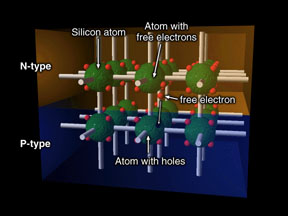 The image to the left shows a silicon semiconductor. Atoms of silicon are stacked perfectly in the form of a crystal into which a small amount of another type of atom is intoduced. In this configuration, each silicon atom shares its outer electrons with its neighbors and their are no free electrons moving about in the crystal due to the silicon atoms. In fact, if there were no other types of atoms in the crystal besides the silicon atoms, the crystal would be an insulator through which currents do not flow under normal circumstances. The image to the left shows a silicon semiconductor. Atoms of silicon are stacked perfectly in the form of a crystal into which a small amount of another type of atom is intoduced. In this configuration, each silicon atom shares its outer electrons with its neighbors and their are no free electrons moving about in the crystal due to the silicon atoms. In fact, if there were no other types of atoms in the crystal besides the silicon atoms, the crystal would be an insulator through which currents do not flow under normal circumstances. In N-type semiconductors, other atoms (called impurity atoms) are introduced in the silicon crystal which have an additional outer electron compared to the silicon atom. When they try to fit into the crystal lattice, the extra electron is not shared by the neighboring silicon atoms and it is free to move about. In a P-type semiconductor, the impurity atoms have one fewer electron than the silicon and thus when they try to fit into the lattice, there is a hole where an electron should be. There are a finite number of free electrons that can carry currents through the semiconductor device. This is the key to understanding how devices, that act as switches, can be built from this material. |





